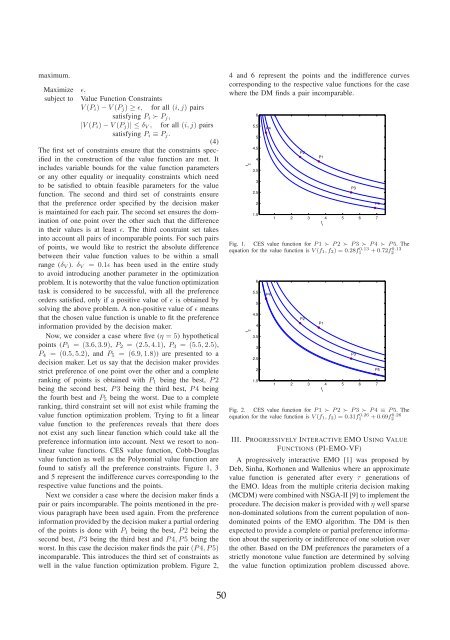Progressively Interactive Evolutionary Multi-Objective Optimization ...
Progressively Interactive Evolutionary Multi-Objective Optimization ...
Progressively Interactive Evolutionary Multi-Objective Optimization ...
You also want an ePaper? Increase the reach of your titles
YUMPU automatically turns print PDFs into web optimized ePapers that Google loves.
maximum.<br />
Maximize ǫ,<br />
subject to Value Function Constraints<br />
V (Pi) − V (Pj) ≥ ǫ, for all (i, j) pairs<br />
satisfying Pi ≻ Pj,<br />
|V (Pi) − V (Pj)| ≤ δV , for all (i, j) pairs<br />
satisfying Pi ≡ Pj.<br />
(4)<br />
The first set of constraints ensure that the constraints specified<br />
in the construction of the value function are met. It<br />
includes variable bounds for the value function parameters<br />
or any other equality or inequality constraints which need<br />
to be satisfied to obtain feasible parameters for the value<br />
function. The second and third set of constraints ensure<br />
that the preference order specified by the decision maker<br />
is maintained for each pair. The second set ensures the domination<br />
of one point over the other such that the difference<br />
in their values is at least ǫ. The third constraint set takes<br />
into account all pairs of incomparable points. For such pairs<br />
of points, we would like to restrict the absolute difference<br />
between their value function values to be within a small<br />
range (δV ). δV = 0.1ǫ has been used in the entire study<br />
to avoid introducing another parameter in the optimization<br />
problem. It is noteworthy that the value function optimization<br />
task is considered to be successful, with all the preference<br />
orders satisfied, only if a positive value of ǫ is obtained by<br />
solving the above problem. A non-positive value of ǫ means<br />
that the chosen value function is unable to fit the preference<br />
information provided by the decision maker.<br />
Now, we consider a case where five (η = 5) hypothetical<br />
points (P1 = (3.6, 3.9), P2 = (2.5, 4.1), P3 = (5.5, 2.5),<br />
P4 = (0.5, 5.2), and P5 = (6.9, 1.8)) are presented to a<br />
decision maker. Let us say that the decision maker provides<br />
strict preference of one point over the other and a complete<br />
ranking of points is obtained with P1 being the best, P 2<br />
being the second best, P 3 being the third best, P 4 being<br />
the fourth best and P5 being the worst. Due to a complete<br />
ranking, third constraint set will not exist while framing the<br />
value function optimization problem. Trying to fit a linear<br />
value function to the preferences reveals that there does<br />
not exist any such linear function which could take all the<br />
preference information into account. Next we resort to nonlinear<br />
value functions. CES value function, Cobb-Douglas<br />
value function as well as the Polynomial value function are<br />
found to satisfy all the preference constraints. Figure 1, 3<br />
and 5 represent the indifference curves corresponding to the<br />
respective value functions and the points.<br />
Next we consider a case where the decision maker finds a<br />
pair or pairs incomparable. The points mentioned in the previous<br />
paragraph have been used again. From the preference<br />
information provided by the decision maker a partial ordering<br />
of the points is done with P1 being the best, P 2 being the<br />
second best, P 3 being the third best and P 4, P 5 being the<br />
worst. In this case the decision maker finds the pair (P 4, P 5)<br />
incomparable. This introduces the third set of constraints as<br />
well in the value function optimization problem. Figure 2,<br />
50<br />
4 and 6 represent the points and the indifference curves<br />
corresponding to the respective value functions for the case<br />
where the DM finds a pair incomparable.<br />
f 2<br />
6<br />
5.5<br />
5<br />
4.5<br />
4<br />
3.5<br />
3<br />
2.5<br />
2<br />
1.5<br />
P4<br />
P2<br />
P1<br />
1 2 3 4 5 6 7<br />
f<br />
1<br />
Fig. 1. CES value function for P 1 ≻ P 2 ≻ P 3 ≻ P 4 ≻ P 5. The<br />
equation for the value function is V (f1, f2) = 0.28f 0.13<br />
1 + 0.72f 0.13<br />
2<br />
f 2<br />
6<br />
5.5<br />
5<br />
4.5<br />
4<br />
3.5<br />
3<br />
2.5<br />
2<br />
1.5<br />
P4<br />
P2<br />
P1<br />
1 2 3 4 5 6 7<br />
f<br />
1<br />
Fig. 2. CES value function for P 1 ≻ P 2 ≻ P 3 ≻ P 4 ≡ P 5. The<br />
equation for the value function is V (f1, f2) = 0.31f 0.26<br />
1 + 0.69f 0.26<br />
2<br />
III. PROGRESSIVELY INTERACTIVE EMO USING VALUE<br />
FUNCTIONS (PI-EMO-VF)<br />
A progressively interactive EMO [1] was proposed by<br />
Deb, Sinha, Korhonen and Wallenius where an approximate<br />
value function is generated after every τ generations of<br />
the EMO. Ideas from the multiple criteria decision making<br />
(MCDM) were combined with NSGA-II [9] to implement the<br />
procedure. The decision maker is provided with η well sparse<br />
non-dominated solutions from the current population of nondominated<br />
points of the EMO algorithm. The DM is then<br />
expected to provide a complete or partial preference information<br />
about the superiority or indifference of one solution over<br />
the other. Based on the DM preferences the parameters of a<br />
strictly monotone value function are determined by solving<br />
the value function optimization problem discussed above.<br />
P3<br />
P3<br />
P5<br />
P5
















